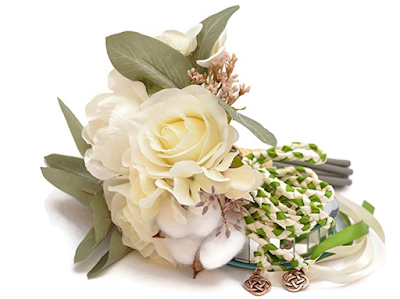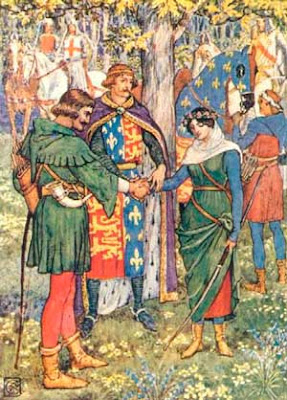Thinking of adding the symbolism of the handfasting ceremony to your wedding and would like to know more about it? As I delved into the history, I found many variations of this tradition, but the deeper I looked, the more I realized that much of what I thought I knew was, in fact, romanticized versions of handfasting “history.” For this post, first, I’ll include the embellished stories, and then for those interested in a more accurate account, I’ll offer that too.
Celtic handfasting
In ancient times, pagan worship included handfasting ceremonies and weddings. When the Celts migrated from Europe and settled in Britain around 7000 BC, they brought the ritual with them, and the practice continued well through the Tudor Period.
Back then, handfasting wasn’t part of the wedding but took place a year and a day before the wedding. It represented a couple’s commitment to each other, as well as the intent to get married. The couple agreed to live in a binding relationship as a trial marriage for a year and a day. During this trial run, the couple learned whether or not they could survive married life together. When the time was up the couple either broke up or chose to marry permanently. This handfasting ceremony was performed in the presence of an upstanding member of the community like the local vicar, constable, or a wealthy landowner.
Handfasting in the British Isles
Handfasting was a custom practiced in the British Isles where it could be weeks or months before a clergyman stopped by rural villages. Here, handfasting was the equivalent to a common-law marriage of today. The bride and groom just clasped hands and professed themselves, husband and wife. Most of the time this was performed before witnesses and was referred to as an irregular marriage. As long as the bride and groom had reached the age of consent (12 for brides, 14 for grooms) and were not too closely related, irregular marriages were as valid as regular marriages. There were three types of irregular marriages:
- Public declaration by the couple that they were husband and wife, followed by the consummation of the relationship
- Mutual agreement
- Living together and being recognized as husband and wife.
Christian handfasting ceremony
The influence of Christianity in the 16th century changed things up when it came to weddings. Many Protestant countries required a priest or minister for a marriage to be valid. In 1563 the Council of Trent did the same for the Roman Catholics. Marriage in the church became known as a regular marriage (valid marriage). The handfasting ceremony was performed by a clergyman and considered binding and legal in every way.
Where did the handfasting ritual come from?
It turns out that the origins of the handfasting ritual are found in Southern Scotland and Northern England Germanic. Their wedding customs succeeded Roman rites and consisted of two parts. First, the betrothal ceremony, followed by the giving away ceremony. The betrothal ceremony included a wedding contract where both sides agreed on terms. Once agreed upon, the contract was sealed with a handshake (clasping of hands--like all contracts were back then). The Anglo-Saxon term for this was “Handfæstung.” Similar terms are found in other Germanic languages. Over time, betrothals in Scotland and England became known as handfasting.
In the 1600s, after churches became involved, the wedding ceremony still took place outside the church. Some churches had a “marriage porch” for this purpose. Once the couple announced their consent before witnesses, including the priest, they clasped hands and kissed. Then all the people moved inside for the celebration of the Mass. (If the couple didn’t regularly attend church, they could wait and go to Mass the following Sunday, but this was not legally required.)
As for the idea of the year and a day trial marriage. It turns out that comes from modern romantic novels, and the concept was picked up by non-fiction writers (like me!) So handfasting with ribbons and cords wasn’t an ancient Celtic custom or even an ancient Scots custom. It turns out the handfasting ceremony we have today arose from a mix of old Germanic traditions (after conversion to Christianity), the romanticized concepts of modern writers like Sir Walter Scott, and old Scottish irregular marriages.
Meaning of handfasting today
With all this said, I still love the idea of the handfasting ceremony as we know it today. It still represents love and fidelity. Now that you know where it comes from, you can feel free to adopt it and make it your own. If you wonder where to start, check out the meaning of colors for handfasting cords. It can add another level of meaning between the bride and groom on their special day.
* * *








